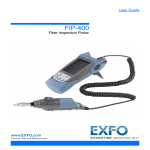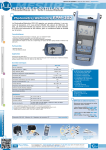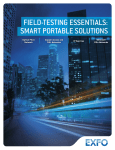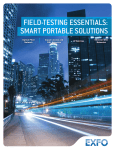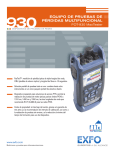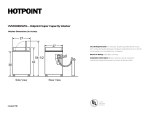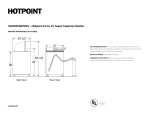Download User Guide - Gap Wireless
Transcript
FiberBasix Testers FiberBasix Testers FiberBasix Te EPM-100/ELS-100/EOT-100 EPM-100/ELS-100/EOT-100 EPM-100/ELS-100/EOT User Guide User Guide User Guide P/N: 1039113 P/N: 1039113 P/N: 1039113 CORPORATE HEADQUARTERS 400 Godin Avenue Vanier (Quebec) G1M 2K2 CANADA Tel.: 1 418 683-0211 · Fax: 1 418 683-2170 CORPORATE HEADQUARTERS 400 Godin Avenue Vanier (Quebec) G1M 2K2 CANADA Tel.: 1 418 683-0211 · Fax: 1 418 683-2170 CORPORATE HEADQUARTERS 400 Godin Avenue Vanier (Quebec) G1M 2K2 CANADA Tel.: 1 418 683-0211 · Fax: 1 418 683- EXFO AMERICA 4275 Kellway Circle, Suite 122 Addison TX, 75001 USA Tel.: 1 972 836-0100 · Fax: 1 972 836-0164 EXFO AMERICA 4275 Kellway Circle, Suite 122 Addison TX, 75001 USA Tel.: 1 972 836-0100 · Fax: 1 972 836-0164 EXFO AMERICA 4275 Kellway Circle, Suite 122 Addison TX, 75001 USA Tel.: 1 972 836-0100 · Fax: 1 972 836- EXFO EUROPE Le Dynasteur 10/12, rue Andras Beck 92366 Meudon la Forêt Cedex FRANCE Tel.: +33.1.40.83.85.85 · Fax: +33.1.40.83.04.42 EXFO EUROPE Le Dynasteur 10/12, rue Andras Beck 92366 Meudon la Forêt Cedex FRANCE Tel.: +33.1.40.83.85.85 · Fax: +33.1.40.83.04.42 EXFO EUROPE Le Dynasteur 10/12, rue Andras Beck 92366 Meudon la Forêt Cedex FRANCE Tel.: +33.1.40.83.85.85 · Fax: +33.1.40. EXFO ASIAPACIFIC 151 Chin Swee Road #03-29, Manhattan House SINGAPORE 169876 Tel.: +65 6333 8241 · Fax: +65 6333 8242 EXFO ASIAPACIFIC 151 Chin Swee Road #03-29, Manhattan House SINGAPORE 169876 Tel.: +65 6333 8241 · Fax: +65 6333 8242 EXFO ASIAPACIFIC 151 Chin Swee Road #03-29, Manhattan House SINGAPORE 169876 Tel.: +65 6333 8241 · Fax: +65 6333 8 TOLL-FREE (USA and Canada) 1 800 663-3936 TOLL-FREE (USA and Canada) 1 800 663-3936 TOLL-FREE (USA and Canada) 1 800 663-3936 © 2004 EXFO Electro-Optical Engineering Inc. All rights reserved. Printed in Canada. www.exfo.com · [email protected] www.exfo.com · [email protected] www.exfo.com · [email protected] © 2004 EXFO Electro-Optical Engineering Inc. All rights reserved. Printed in Canada. © 2004 EXFO Electro-Optical Engineering Inc. All rights reserved. Printed in Canada. EPM-100 Power Meter ELS-100 Light Source EOT-100 Loss Test Set User Guide P/N: 1039113 May 2004 All rights reserved. No part of this publication may be reproduced, stored in a retrieval system or transmitted in any form, be it electronically, mechanically, or by any other means such as photocopying, recording or otherwise, without the prior written permission of EXFO Electro-Optical Engineering Inc. (EXFO). Information provided by EXFO is believed to be accurate and reliable. However, no responsibility is assumed by EXFO for its use nor for any infringements of patents or other rights of third parties that may result from its use. No license is granted by implication or otherwise under any patent rights of EXFO. EXFO’s Commerce And Government Entities (CAGE) code under the North Atlantic Treaty Organization (NATO) is 0L8C3. Trademarks EXFO’s trademarks have been identified as such. However, the presence or absence of such identification does not affect the legal status of any trademark. Units of Measurement Units of measurement in this publication conform to SI standards and practices. The information contained in this publication is subject to change without notice. © 2004 EXFO Electro-Optical Engineering Inc. Contents Certification Information ................................................................................. iv 1 Introducing the EPM-100/ELS-100/EOT-100 .............................. 1 Main Features ................................................................................................... 1 Power Sources .................................................................................................. 2 Typical Applications .......................................................................................... 2 2 Safety Information ................................................................... 3 Safety Conventions ........................................................................................... 3 Electrical Safety Information ............................................................................. 3 Laser Safety Information (ELS-100 and EOT-100 with VCSEL) ........................... 4 Laser Safety Information (ELS-100 and EOT-100 without VCSEL) ...................... 4 3 Getting Started ......................................................................... 5 Turning the Unit On and Off ............................................................................. 5 Activating Automatic Shutdown (Auto-Off) ...................................................... 6 Installing the EXFO Universal Interface (EUI) ..................................................... 6 Cleaning and Connecting Optical Fibers ........................................................... 7 4 Measuring Power or Loss (EPM-100 and EOT-100) .................. 8 Nulling Electrical Offsets ................................................................................... 8 Referencing Your Power Meter to a Source ....................................................... 8 Measuring Power or Loss .................................................................................. 9 5 Using a Light Source (ELS-100 and EOT-100) ......................... 11 6 Maintenance ............................................................................ 12 Cleaning EUI Connectors ................................................................................ 12 Cleaning Fixed Connectors .............................................................................. 14 Cleaning Detector Ports .................................................................................. 15 Replacing Disposable Alkaline Batteries .......................................................... 16 Recalibrating the Unit ..................................................................................... 16 7 Troubleshooting ...................................................................... 17 Error Codes and Descriptions .......................................................................... 17 Contacting the Technical Support Group ........................................................ 18 Finding Information on the EXFO Web Site .................................................... 19 Transportation ................................................................................................ 19 8 Warranty .................................................................................. 20 General Information ....................................................................................... 20 Liability ........................................................................................................... 20 Exclusions ....................................................................................................... 20 Certification .................................................................................................... 21 Service and Repairs ......................................................................................... 21 EXFO Service Centers Worldwide .................................................................... 22 A Technical Specifications .......................................................... 23 EPM-100/ELS-100/EOT-100 iii Certification Information iv Certification Information F.C.C. Information Electronic test equipment is exempt from Part 15 compliance (FCC) in the United States. However, compliance verification tests are systematically performed on most EXFO equipment. Information Electronic test equipment is subject to the EMC Directive in the European Union. The EN61326 standard prescribes both emission and immunity requirements for laboratory, measurement, and control equipment. This unit has undergone extensive testing according to the European Union Directive and Standards. DECLARATION OF CONFORMITY Application of Council Directive(s): Manufacturer’s Name: Manufacturer’s Address: Equipment Type/Environment: Trade Name/Model No.: 73/23/EEC - The Low Voltage Directive 89/336/EEC - The EMC Directive EXFO ELECTRO-OPTICAL ENG. 400 Godin Avenue Vanier, Québec Canada G1M 2K2 (418) 683-0211 Industrial Scientific Equipment EPM-100 Power Meter, ELS-100 Light Source, EOT-100 OLTS Standard(s) to which Conformity is Declared: EN 60825-1: 1994/ A2: 2001 Safety of Laser Products-Part 1: Equipment Classification, Requirement, and User’s guide EN 61326: 1997/ A2: 2001 Electrical Equipment for Measurement, Control and Laboratory Use - EMC Requirements EN 55022: 1998/ A1: 2000 Limits and methods of measurement of radio disturbance characteristics of information technology equipment I, the undersigned, hereby declare that the equipment specified above conforms to the above Directive and Standards. Manufacturer Signature: Full Name: Stephen Bull, E. Eng Position: Vice-President Research and Development Address: 400 Godin Avenue Vanier, Quebec, Canada December 15, 2003 Date: 1 Introducing the EPM-100/ELS-100/EOT-100 This user guide covers the following products (unless otherwise specified, descriptions apply to all): ³ EPM-100 Power Meter ³ ELS-100 Light Source ³ EOT-100 Loss Test Set: combines both a power meter and a light source Main Features EPM ELS EOT Ge or GeX detector with 6 calibrated wavelengths X X Absolute power and link loss measurements X X No offset nulling of detectors required in normal operation X X Multiple source configurations on a single port [EOT-100] or on one or two ports [ELS-100] Automatic shutdown after 10 minutes of idle time (auto-off) X X X X X LCD display Shoulder strap eyelet Keypad (EOT-100 shown) DC connector Stand EPM-100/ELS-100/EOT-100 1 Introducing the EPM-100/ELS-100/EOT-100 Power meter detector port EPM-100 2 Light source ports EOT-100 Safety label and serial number (under the stand) ELS-100 Quick reference label Battery compartment (3 alkaline batteries) Power Sources The units operate with the following power sources: ³ AC adapter (connected to standard power outlet—indoor use only) ³ AA alkaline batteries (automatically take over if you unplug the AC adapter) IMPORTANT If the battery level becomes too low, the unit turns itself off. Typical Applications ³ Transmitter power measurements (dBm and W) ³ Fiber-link loss testing (dB) ³ Component insertion-loss testing (dB) ³ Installation and maintenance applications 2 Safety Information Safety Conventions Before using the product described in this manual, you should understand the following conventions: WARNING Indicates a potentially hazardous situation which, if not avoided, could result in death or serious injury. Do not proceed unless you understand and meet the required conditions. CAUTION Indicates a potentially hazardous situation which, if not avoided, may result in minor or moderate injury. Do not proceed unless you understand and meet the required conditions. CAUTION Indicates a potentially hazardous situation which, if not avoided, may result in component damage. Do not proceed unless you understand and meet the required conditions. IMPORTANT Refers to information about this product you should not overlook. Electrical Safety Information WARNING Use the AC adapter provided with this product indoors only. 6 -16 V DC 150 mA QST519 A EPM-100/ELS-100/EOT-100 3 Safety Information 4 Laser Safety Information (ELS-100 and EOT-100 with VCSEL) WARNING Do not install or terminate fibers while a laser source is active. Never look directly into a live fiber and ensure that your eyes are protected at all times. WARNING Use of controls, adjustments and procedures for operation and maintenance other than those specified herein may result in hazardous radiation exposure. Your instrument is a Class 1M laser product in compliance with standards IEC 60825-1 Amendment 2: 2001 and 21 CFR 1040.10. Laser radiation may be encountered at the output port. The product is safe under reasonably forseeable conditions of operation but it may be hazardous if you use optics within a diverging or collimated beam. Do not view directly with optical instruments. Note: Label shown for information purposes only. It is not affixed to your product. Laser Safety Information (ELS-100 and EOT-100 without VCSEL) Your instrument is a Class 1 laser or LED product in compliance with standards IEC 60825-1 Amendment 2: 2001 and 21 CFR 1040.10. Laser radiation may be encountered at the output port. The following labels indicate that a product contains a Class 1 source: CLASS 1 LASER PRODUCT Note: CLASS 1 LED PRODUCT Labels shown for information purposes only. They are not affixed to your product. 3 Getting Started Turning the Unit On and Off When you turn the EPM-100 or EOT-100 off, it saves the current wavelength, unit and reference power. IMPORTANT If you remove batteries (and the AC adapter is unplugged), the unit will turn off without saving the above values. If batteries are low (and the AC adapter is unplugged), the unit will save the above values and turn off. Note: Offset nulling values are always returned to factory settings. To turn the unit on: Press . The unit displays EXFO for a few seconds. You may use it immediately under normal conditions. To turn the unit off: From normal operating mode, hold down a few seconds. Display Power meter wavelength or reference power (EPM/EOT) Source wavelength (EOT) AC adapter plugged in Batteries in use (with level) Measured power/loss (EPM/EOT) Active source wavelength (ELS) Auto-off activated Keypad ELS-100 EOT-100 Turns unit on/off Controls auto-off Exits special modes EPM-100 EOT-100 PRESS: Selects wavelength Switches between measurement units EPM-100/ELS-100/EOT-100 PRESS: Activates next source HOLD: Deactivates current source PRESS: Displays dB units HOLD: Sets input power as reference power 5 Getting Started 6 Activating Automatic Shutdown (Auto-Off) When auto-off is activated, the unit will turn itself off after 10 minutes of idle time. Auto-off is activated by default when you turn unit on. To deactivate/reactivate auto-off: Press . Installing the EXFO Universal Interface (EUI) The EUI fixed baseplate is available for connectors with angled (APC) or non-angled (UPC) polishing. A green border around the baseplate indicates that it is for APC-type connectors, as shown below: Bare metal (or blue border) indicates UPC option Green border indicates APC option To install an EUI connector adapter onto the EUI baseplate: 1. Hold the EUI connector adapter so the dust cap opens downwards. 3 2 4 2. Close the dust cap in order to hold the connector adapter more firmly. 3. Insert the connector adapter into the baseplate. 4. While pushing firmly, turn the connector adapter clockwise on the baseplate to lock it in place. Cleaning and Connecting Optical Fibers IMPORTANT To ensure maximum power and to avoid erroneous readings: ³ Always clean fiber ends as explained below before inserting them into the port. EXFO is not responsible for damage or errors caused by bad fiber cleaning or handling. ³ Ensure that your patchcord has appropriate connectors. Joining mismatched connectors will damage the ferrules. To connect the fiber-optic cable to the port: 1. Clean the fiber ends as follows: 1a. Gently wipe the fiber end with a lint-free swab dipped in isopropyl alcohol. 1b. Use compressed air to dry completely. 1c. Visually inspect the fiber end to ensure its cleanliness. 2. Carefully align the connector and port to prevent the fiber end from touching the outside of the port or rubbing against other surfaces. If your connector features a key, ensure that it is fully fitted into the port’s corresponding notch. 3. Push the connector in so that the fiber-optic cable is firmly in place, thus ensuring adequate contact. If your connector features a screwsleeve, tighten the connector enough to firmly maintain the fiber in place. Do not overtighten, as this will damage the fiber and the port. Note: If your fiber-optic cable is not properly aligned and/or connected, you will notice heavy loss and reflection. EPM-100/ELS-100/EOT-100 7 Measuring Power or Loss (EPM-100 and EOT-100) 8 4 Measuring Power or Loss (EPM-100 and EOT-100) Nulling Electrical Offsets Temperature and humidity variations affect the performance of electronic circuits and optical detectors. Nulling the electrical offsets eliminates these effects. Your unit has been designed not to require offset nulling under normal operation, but you should perform it whenever environmental conditions change significantly or when measuring very low power values. IMPORTANT If light reaches the detector when nulling offsets, LIGH appears on the display and the nulling is not performed. You will need to press a key to return to the previous display. Note: Factory-defined values will be reinstated when you turn the unit off. To perform an offset nulling: dBm/W Hold down dB and λ (power meter) a few seconds. The unit displays NULL while nulling the offsets, then returns to normal mode. Note: Keypad is disabled during the operation. Referencing Your Power Meter to a Source In reference mode, your unit displays the loss created by the fiber under test only, since a reference value is subtracted from the measured power. Note: You must set a reference value separately for each wavelength. To reference the power meter to a source manually: 1. Using the proper adapter, connect a light source (such as ELS-100 or EOT-100) to the detector port of your power meter. Reference test jumper Reference test jumper Adapter Bulkhead connector Light source 2. Activate the source at the desired wavelength. Power meter 3. Press λ (power meter) to switch between calibrated wavelengths. 4. Hold down REF a few seconds. The power meter stores the currently detected power as the new reference power. Reference power is displayed in the top right corner (in dBm) and current loss reading is automatically switched to dB. 5. Repeat the procedure for each wavelength you want to reference. Note: When using dB units, press λ (power meter) to display the current wavelength for a few seconds. To change this wavelength, press again while it is displayed. λ Measuring Power or Loss Measuring absolute power or link loss is done the same way, except for the referencing step. To perform power or loss measurements: 1. If necessary, perform an offset nulling (see Nulling Electrical Offsets on page 8). 2. Check and clean your fibers appropriately for optimum performance (see Cleaning and Connecting Optical Fibers on page 7). 3. For loss measurements, reference your power meter to a light source (see Referencing Your Power Meter to a Source on page 8), then deactivate the light source. 4. Using the proper adapter and test jumpers, connect a fiber under test to a light source (such as ELS-100 or EOT-100) and to the detector port of your unit. Note: If you have referenced your power meter to a source, simply connect a fiber under test to the test jumpers used for referencing. Test jumper Test jumper Bulkhead connector Adapter Bulkhead connector Fiber under test Light source Power meter 5. Activate the source at the desired wavelength. EPM-100/ELS-100/EOT-100 9 Measuring Power or Loss (EPM-100 and EOT-100) 6. Press 10 λ (power meter) to switch between calibrated wavelengths. 7. If your want to see a loss value and your power meter displays W or dBm units, press REF to access reference mode. Actual power or loss of fiber under test When power or loss is outside power limits (see Technical Specifications on page 23) 8. If necessary, change the displayed units by pressing 9. Repeat the procedure for other wavelengths. dBm/W dB . 5 Using a Light Source (ELS-100 and EOT-100) The ELS-100 may contain up to three sources (one-port models) or up to four sources (two-port models). The EOT-100 may contain up to three sources. Only one source may be active at a time. When no source is active, the unit displays NONE (ELS-100) or leaves the top left corner empty (EOT-100). Source wavelength (when source active) EOT-100 Moving bars indicate active source port ELS-100 To activate a light source and change the wavelength: Press λ (source) to activate each available source in turn. The unit displays the wavelength. To deactivate the light source: λ (source) until you get past the last source. ³ Press OR ³ Hold down λ (source) a few seconds. EPM-100/ELS-100/EOT-100 11 Maintenance 12 6 Maintenance This product contains no user-serviceable parts. However, it contains sensitive electronic and optical components, and should be handled carefully and stored in its carrying case when not in use. To help ensure long, trouble-free operation: ³ Always clean fiber-optic connectors before using them. ³ Keep the unit free of dust. ³ Clean the unit casing and front panel with a cloth slightly dampened with water. ³ Store unit at room temperature in a clean and dry area. Keep the unit out of direct sunlight. ³ Avoid high humidity or significant temperature fluctuations. ³ Avoid unnecessary shocks and vibrations. ³ If any liquids are spilled on or into the unit, turn off the power immediately and let the unit dry completely. WARNING Use of controls, adjustments and procedures for operation and maintenance other than those specified herein may result in hazardous radiation exposure. Cleaning EUI Connectors Regular cleaning of EUI connectors will help maintain optimum performance. There is no need to disassemble the unit. IMPORTANT If any damage occurs to internal connectors, the module casing will have to be opened and a new calibration will be required. To clean EUI connectors: 1. Remove the EUI from the instrument to expose the connector baseplate and ferrule. Turn Push Pull 2. Moisten a 2.5 mm cleaning tip provided by EXFO with one drop of isopropyl alcohol (alcohol may leave traces if used abundantly). 3. Slowly insert the cleaning tip into the EUI adapter until it comes out on the other side (a slow clockwise rotating movement may help). 4 3 5 4. Gently turn the cleaning tip one full turn, then continue to turn as you withdraw it. 5. Repeat steps 3 to 4 with a dry cleaning tip. Note: Make sure you don’t touch the soft end of the cleaning tip. 6. Clean the ferrule in the connector port as follows: 6a. Deposit one drop of isopropyl alcohol on a lint-free wiping cloth. IMPORTANT Since isopropyl alcohol is not absolutely pure, it may leave residues if used abundantly or left to evaporate (about 10 seconds). Avoid contact between the tip of the bottle and the wiping cloth, dry the surface quickly, and use a bottle that distributes only a drop of alcohol at a time. 6b. Gently wipe the connector and ferrule. 6c. With a dry lint-free wiping cloth, gently wipe the same surfaces to ensure that the connector and ferrule are perfectly dry. 6d. Verify connector surface with a portable fiber-optic microscope (e.g., EXFO’s FOMS) or fiber inspection probe (e.g., EXFO’s FIP). WARNING Verifying the surface of the connector WHILE THE UNIT IS ACTIVE WILL result in permanent eye damage. 7. Put the EUI back onto the instrument (push and turn clockwise). 8. Throw out cleaning tips and wiping clothes after one use. EPM-100/ELS-100/EOT-100 13 Maintenance 14 Cleaning Fixed Connectors Regular cleaning of connectors will help maintain optimum performance. Do not try to disassemble the unit. Doing so would break the connector. To clean fixed connectors: 1. Fold a lint-free wiping cloth in four to form a square. 2. Moisten the center of the lint-free wiping cloth with only one drop of isopropyl alcohol. IMPORTANT Alcohol may leave traces if used abundantly. Avoid contact between the tip of the bottle and the wiping cloth, and do not use bottles that distribute too much alcohol at a time. 3. Gently wipe the connector threads three times with the folded and moistened section of the wiping cloth. IMPORTANT Isopropyl alcohol takes approximately ten seconds to evaporate. Since isopropyl alcohol is not absolutely pure, evaporation will leave microscopic residue. Make sure you dry the surfaces before evaporation occurs. 4. With a dry lint-free wiping cloth, gently wipe the same surfaces three times with a rotating movement. 5. Throw out the wiping cloths after one use. 6. Moisten a cleaning tip (2.5 mm tip) provided by EXFO with only one drop of isopropyl alcohol. IMPORTANT Alcohol may leave traces if used abundantly. Avoid contact between the tip of the bottle and the cleaning tip, and do not use bottles that distribute too much alcohol at a time. 7. Slowly insert the cleaning tip into the connector until it reaches the ferrule inside (a slow clockwise rotating movement may help). 8 7 9 8. Gently turn the cleaning tip one full turn. 9. Continue to turn as you withdraw the cleaning tip. 10. Repeat steps 7 to 9, but this time with a dry cleaning tip (2.5 mm tip provided by EXFO). Note: Make sure you don’t touch the soft end of the cleaning tip and verify the cleanliness of the cotton tip. 11. Throw out the cleaning tips after one use. Cleaning Detector Ports Regular cleaning of detectors will help maintain measurement accuracy. IMPORTANT Always cover detectors with protective caps when unit is not in use. To clean detector ports: 1. Remove the protective cap and adapter (FOA) from the detector. 2. If the detector is dusty, blow dry with compressed air. 3. Being careful not to touch the soft end of the swab, moisten a supplied cleaning tip with only one drop of isopropyl alcohol. IMPORTANT Alcohol may leave traces if used abundantly. Do not use bottles that distribute too much alcohol at a time. 4. While applying light pressure (to avoid breaking the detector window), gently rotate the cleaning tip on the detector window. 5. Repeat step 4 with a dry cleaning tip or blow dry with compressed air. 6. Discard the cleaning tips after one use. EPM-100/ELS-100/EOT-100 15 Maintenance 16 Replacing Disposable Alkaline Batteries Your unit requires three AA alkaline batteries. Note: The AC adapter (provided with the unit) is not a charger. To replace disposable alkaline batteries: 1. Turn off the unit (if the AC adapter is plugged in, you may replace batteries while unit is on). + + + 2. Open the battery compartment door located at the back of the unit. 3. Replace batteries, respecting the polarity as shown. 4. Close the battery compartment door. WARNING Do not throw batteries into fire or water and do not short-circuit the batteries’ electrical contacts. Recalibrating the Unit EXFO’s manufacturing and service center calibrations are based on the ISO/IEC 17025 Standard, which states that calibration documents must not contain a recommended calibration interval, unless this has been previously agreed upon with the customer. Validity of specifications depends on operating conditions. For example, the calibration validity period can be longer or shorter depending on the intensity of use, environmental conditions and unit maintenance. You should determine the adequate calibration interval for your unit according to your accuracy requirements. Under normal use, EXFO recommends calibrating your unit every year. Note: The FlexCare warranty program includes Calibration/Verification packages (see Service and Repairs on page 29). To view the last calibration date (EOT-100 and EPM-100 only): 1. Hold down λ (power meter) and press at the same time. The unit displays the main embedded software version. 2. Press λ (power meter) to display the calibration date of the power meter. 3. Press to return to normal mode. 7 Troubleshooting Error Codes and Descriptions ³ ER: error code displayed until you press a key. ³ WR: warning code displayed for 3 seconds, then unit returns to normal. Error Code LIGH Description Light detected while nulling offsets. Nulling is not performed. ER 10/11 Embedded software problem. WR 22 ER 13 EEPROM corrupted (would occur during unit initialization). EPM-100/ELS-100/EOT-100 Solution Correctly place protective cap on detector port, then retry. Contact EXFO. Unit must be recalibrated. Contact EXFO. 17 Troubleshooting 18 Contacting the Technical Support Group To obtain after-sales service or technical support for this product, contact EXFO at one of the following numbers. The Technical Support Group is available to take your calls from Monday to Friday, 7:30 a.m. to 8:00 p.m. (Eastern Time in North America). Technical Support Group 400 Godin Avenue Vanier (Quebec) G1M 2K2 CANADA 1 866 683-0155 (USA and Canada) Tel.: 1 418 683-5498 Fax: 1 418 683-9224 [email protected] To accelerate the process, please have information such as the name and the serial number (see the product identification label—an example is shown below), as well as a description of your problem, close at hand. P/N S/N **************** 542392-3D A January Made in Canada EPM-10XX Ver. 2003 Mfg. date QST442B 465 Godin Avenue Vanier (Quebec) G1M 3G7 CANADA ELS-100-XX-XX-XX Detector type Source ports Source connector EOT-10XX-XX-XX You may also be requested to provide the embedded software’s version numbers. To display the embedded software version: 1. Hold down λ (power meter or source) and press at the same time. The unit displays the main software version. 2. [ELS-100 and EOT-100] Press λ (source) to toggle between the main and the source’s software versions. 3. Press to return to normal mode. Finding Information on the EXFO Web Site The EXFO Web site provides answers to frequently asked questions (FAQs) regarding the use of your EPM-100/ELS-100/EOT-100. To access FAQs: 1. Type http://www.exfo.com in your Internet browser. 2. Click on the Support tab. 3. Click on FAQs and follow the on-screen instructions. You will be given a list of questions pertaining to your subject. The EXFO Web site also provides the product’s most recent technical specifications. Transportation Maintain a temperature range within specifications when transporting the unit. Transportation damage can occur from improper handling. The following steps are recommended to minimize the possibility of damage: ³ Pack the unit in its original packing material when shipping. ³ Avoid high humidity or large temperature fluctuations. ³ Keep the unit out of direct sunlight. ³ Avoid unnecessary shock and vibration. EPM-100/ELS-100/EOT-100 19 Warranty 20 8 Warranty General Information EXFO Electro-Optical Engineering Inc. (EXFO) warrants this equipment against defects in material and workmanship for a period of one year from the date of original shipment. EXFO also warrants that this equipment will meet applicable specifications under normal use. During the warranty period, EXFO will, at its discretion, repair, replace, or issue credit for any defective product, as well as recalibrate the product free of charge should the equipment need to be repaired or if the original calibration is erroneous. IMPORTANT The warranty can become null and void if: ³ unit has been tampered with, repaired, or worked upon by unauthorized individuals or non-EXFO personnel. ³ warranty sticker has been removed. ³ case screws, other than those specified in this guide, have been removed. ³ case has been opened, other than as explained in this guide. ³ unit serial number has been altered, erased, or removed. ³ unit has been misused, neglected, or damaged by accident. THIS WARRANTY IS IN LIEU OF ALL OTHER WARRANTIES EXPRESSED, IMPLIED, OR STATUTORY, INCLUDING, BUT NOT LIMITED TO, THE IMPLIED WARRANTIES OF MERCHANTABILITY AND FITNESS FOR A PARTICULAR PURPOSE. IN NO EVENT SHALL EXFO BE LIABLE FOR SPECIAL, INCIDENTAL, OR CONSEQUENTIAL DAMAGES. Liability EXFO shall not be liable for damages resulting from the use of the product, nor shall be responsible for any failure in the performance of other items to which the product is connected or the operation of any system of which the product may be a part. EXFO shall not be liable for damages resulting from improper usage or unauthorized modification of the product, its accompanying accessories and software. Exclusions EXFO reserves the right to make changes in the design or construction of any of its products at any time without incurring obligation to make any changes whatsoever on units purchased. Accessories, including but not limited to fuses, pilot lamps, batteries and universal interfaces (EUI) used with EXFO products are not covered by this warranty. This warranty excludes failure resulting from: improper use or installation, normal wear and tear, accident, abuse, neglect, fire, water, lightning or other acts of nature, causes external to the product or other factors beyond EXFO’s control. IMPORTANT EXFO will charge a fee for replacing optical connectors that were damaged due to misuse or bad cleaning. Certification EXFO certifies that this equipment met its published specifications at the time of shipment from the factory. Service and Repairs EXFO commits to providing product service and repair for five years following the date of purchase. To send any equipment for service or repair: 1. Call one of EXFO’s authorized service centers (see EXFO Service Centers Worldwide on page 22). Support personnel will determine if the equipment requires service, repair, or calibration. 2. If equipment must be returned to EXFO or an authorized service center, support personnel will issue a Return Merchandise Authorization (RMA) number and provide an address for return. 3. If possible, back up your data before sending the unit for repair. 4. Pack the equipment in its original shipping material. Be sure to include a statement or report fully detailing the defect and the conditions under which it was observed. 5. Return the equipment, prepaid, to the address given to you by support personnel. Be sure to write the RMA number on the shipping slip. EXFO will refuse and return any package that does not bear an RMA number. Note: A test setup fee will apply to any returned unit that, after test, is found to meet the applicable specifications. After repair, the equipment will be returned with a repair report. If the equipment is not under warranty, you will be invoiced for the cost appearing on this report. EXFO will pay return-to-customer shipping costs for equipment under warranty. Shipping insurance is at your expense. Routine recalibration is not included in any of the warranty plans. Since calibrations/verifications are not covered by the basic or extended warranties, you may elect to purchase FlexCare Calibration/Verification Packages for a definite period of time. Contact an authorized service center (see EXFO Service Centers Worldwide on page 22). EPM-100/ELS-100/EOT-100 21 Warranty 22 EXFO Service Centers Worldwide If your product requires servicing, contact your nearest authorized service center. EXFO Headquarters Service Center 400 Godin Avenue Vanier (Quebec) G1M 2K2 CANADA 1 866 683-0155 (USA and Canada) Tel.: 1 418 683-5498 Fax: 1 418 683-9224 [email protected] EXFO Europe Service Center Le Dynasteur 10/12, rue Andras Beck 92366 Meudon la Forêt Cedex FRANCE Tel.: +33.1.40.83.85.85 Fax: +33.1.40.83.04.42 [email protected] EXFO China Service Center/ Beijing OSIC Beijing New Century Hotel Office Tower, Room 1754-1755 No. 6 Southern Capital Gym Road Beijing 100044 P. R. CHINA Tel.: +86 (10) 6849 2738 Fax: +86 (10) 6849 2662 [email protected] A Technical Specifications IMPORTANT The following technical specifications can change without notice. The information presented in this section is provided as a reference only. To obtain this product’s most recent technical specifications, visit the EXFO Web site at www.exfo.com. ELS-100 Specifications1 Model2 Central wavelength (nm) 23BL 1310 ± 20 1550 ± 20 Spectral width3 (nm) Output power (dBm) Power stability4 (dB) 8 hours Battery life (hours) (typical) Warranty and recommended calibration interval (years) 12D 850 ± 25 1300 +50/-10 01-VCL 850 ± 20 ≤5 ≥ 1/≥ 1 235BL 1310 ± 20 1490 ± 10 1550 ± 20 ≤5 ≥ 1/≥ -4.5/≥ -3 50/135 ≥ -18/≥ -18 (62.5/125 µm) ≤1 ≥ -3 (50/125 µm) ± 0.10 50 ± 0.10 45 ± 0.10 55 ± 0.25 250 3 3 3 3 EOT-100 Specifications1 General Specifications Size (H x W x D) Weight Temperature operating storage Relative humidity 18.5 cm x 10.0 cm x 5.5 cm 0.4 kg -10 °C to 50 °C -40 °C to 70 °C 0 % to 95 % non-condensing Model5 Power meter port Power range (dBm)6 Range displayed (dBm) Number of calibrated wavelengths7 Power uncertainty8 Resolution (dB) Automate offset nulling11 Warmup time (s)12 Display units Screen refresh rate (Hz) Battery life (hours) (typical) Warranty and recommended calibration interval (years) EOT-102 Ge 10 to -60 Down to -65 6 ± 5 % ± 1 nW 0.019 Yes 0 dB/dBm/W 3 260 3 EOT-102X GeX 26 to -50 Down to -50 6 ± 5 % ± 10 nW 0.0110 Yes 0 dB/dBm/W 3 260 3 Model2 Central wavelength (nm) 23BL 1310 ± 20 1550 ± 20 12D 850 ± 25 1300 +50/-10 01-VCL 850 ± 20 Spectral width (nm)3 Output power (dBm) Power stability (dB)4 8 hours Battery life (hours) (typical) Automatic wavelength recognition Tone generation (Hz) Warranty and recommended calibration interval (years) ≤5 ≥ 1/≥ 1 235BL 1310 ± 20 1490 ± 10 1550 ± 20 ≤5 ≥ 1/≥ -4.5/≥ -3 50/135 ≥ -18/≥ -18 (62.5/125 µm) ≤1 ≥ -3 (50/125 µm) ± 0.10 50 Yes 270, 1 k, 2 k 3 ± 0.10 45 Yes 270, 1 k, 2 k 3 ± 0.10 55 Yes 270, 1 k, 2 k 3 ± 0.25 250 Yes 270, 1 k, 2 k 3 EPM-100 Specifications1 Model5 Power meter port Power range6 (dBm) Range displayed (dBm) Number of calibrated wavelengths7 Power uncertainty8 Resolution (dB) Automatic offset nulling11 Warmup time6 (s) Display units Screen refresh rate (Hz) Battery life (hours) (typical) Warranty and recommended calibration interval (years) Standard Accessories User guide, Certificate of Calibration, instrument stickers in four languages, AC adapter, connector adapter (FOA-XX), three AA batteries, wrist strap, alcohol cleaning pads. Safety 21 CFR 1040.10 and IEC 60825-1:1993+A1:1997+A2:2001: CLASS 1M LASER PRODUCT Notes EPM-102 Ge 10 to -60 Down to -65 6 ± 5 % ± 1 nW 0.019 Yes 0 dB/dBm/W 3 > 300 6 ± 5 % ± 10 nW 0.0110 Yes 0 dB/dBm/W 3 > 300 3 3 EPM-100/ELS-100/EOT-100 (71/4 in x 4 in x 21/8 in) (0.9 lb) (14 °F to 122 °F) (-40 °F to 158 °F) EPM-102X GeX 26 to -50 Down to -50 1. 2. 3. 4. Guaranteed unless otherwise specified. All specifications valid at 23 °C ± 1 °C, with an FC connector. rms for lasers and FWHM for LEDs; typical values for LEDs. After 15 minutes warmup; expressed as ± half the difference between the maximum and minimum values measured during the period, with an APC connector on the power meter. 5. All specifications valid at 1550 nm and 23 °C ± 1 °C, with an FC connector. 6. In CW mode; sensitivity defined as 6 x rms noise level. 7. Wavelengths: 850 nm, 1300 nm, 1310 nm, 1490 nm, 1550 nm and 1625 nm. 8. Traceable to NIST; EOT-102X: up to 20 dBm. 9. From 10 dBm to -50 dBm. 10. From 26 dBm to -35 dBm. 11. Power > -40 dBm for EOT-102, and > -25 dBm for EOT-102X. 12. For ± 0.05 dB, for temperatures > 18 °C. 23





























